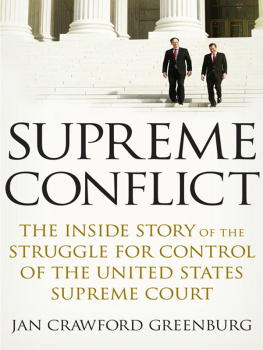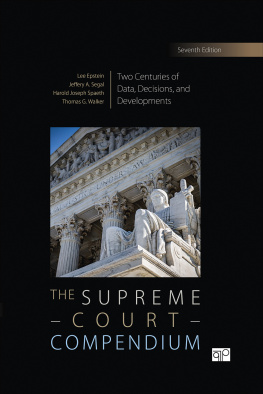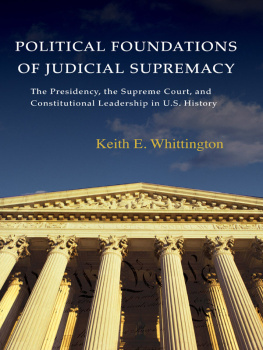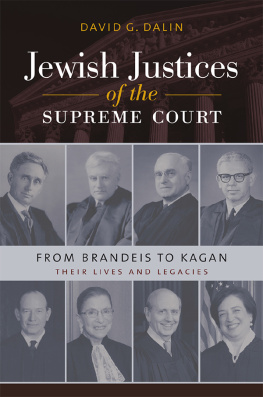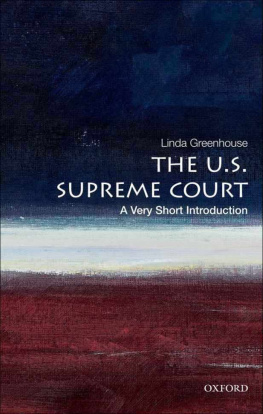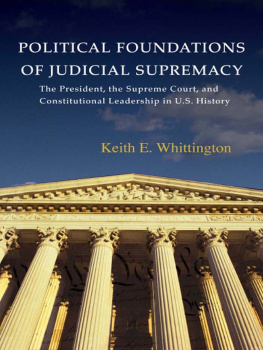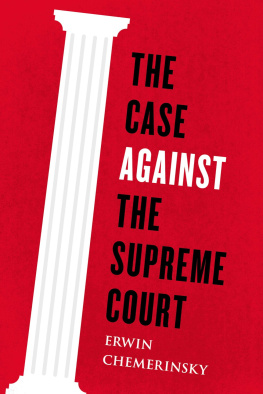SUPREME CONFLICT
THE INSIDE STORY OF THE STRUGGLE FOR
CONTROL OF THE UNITED STATES
SUPREME COURT
JAN CRAWFORD GREENBURG
T HE P ENGUIN P RESS
New York
2007
THE PENGUIN PRESS
Published by the Penguin Group
Penguin Group (USA) Inc., 375 Hudson Street, New York, New York 10014, U.S.A. Penguin Group (Canada), 90 Eglinton Avenue East, Suite 700, Toronto, Ontario, Canada M4P 2Y3 (a division of Pearson Penguin Canada Inc.) Penguin Books Ltd, 80 Strand, London WC2R 0RL, England Penguin Ireland, 25 St. Stephens Green, Dublin 2, Ireland (a division of Penguin Books Ltd) Penguin Books Australia Ltd, 250 Camberwell Road, Camberwell, Victoria 3124, Australia (a division of Pearson Australia Group Pty Ltd) Penguin Books India Pvt Ltd, 11 Community Centre, Panchsheel Park, New Delhi110 117, India Penguin Group (NZ), 67 Apollo Drive, Mairangi Bay, Auckland 1311, New Zealand (a division of Pearson New Zealand Ltd) Penguin Books (South Africa) (Pty) Ltd, 24 Sturdee Avenue, Rosebank, Johannesburg 2196, South Africa
Penguin Books Ltd, Registered Offices:
80 Strand, London WC2R 0RL, England
First published in 2007 by The Penguin Press,
a member of Penguin Group (USA) Inc.
Copyright Jan Crawford Greenburg, 2007
All rights reserved
LIBRARY OF CONGRESS CATALOGING IN PUBLICATION DATA
Greenburg, Jan Crawford.
Supreme conflict: the inside story of the struggle for control of the United States Supreme
Court / Jan Crawford Greenburg.
p. cm.
ISBN: 978-1-1012-0205-0
1. United States. Supreme Court.Officials and employeesSelection and appointmentHistory. 2. JudgesSelection and appointmentUnited StatesHistory. 3. Political questions and judicial powerUnited States. I. Title.
KF8742.G74 2007
347.732634dc22 2006033620
Without limiting the rights under copyright reserved above, no part of this publication may be reproduced, stored in or introduced into a retrieval system, or transmitted, in any form or by any means (electronic, mechanical, photocopying, recording or otherwise), without the prior written permission of both the copyright owner and the above publisher of this book.
The scanning, uploading, and distribution of this book via the Internet or via any other means without the permission of the publisher is illegal and punishable by law. Please purchase only authorized electronic editions and do not participate in or encourage electronic piracy of copyrightable materials. Your support of the authors rights is appreciated.
To Mom and Dad
CONTENTS
SUPREME CONFLICT
PROLOGUE
T he nine justices emerged from behind the red velvet curtains right on time, as always, at 10 a.m. They are never late or early, no matter how small or big the cases before them. They follow a routine dictated by custom and tradition.
About ten minutes beforehand, the associate justices donned their black robes in a paneled changing room just behind the courtroom and gathered next door in the oak-paneled conference room where they meet to discuss cases. The room is just outside the chief justices chambers, and as always, he joined them already wearing his robe. Right before the appointed hour, they all shook hands. Then they walked single file behind their chief, in order of seniority, to wait behind those velvet curtains. As the Courts marshal announced the honorable, the chief justice and the associate justices of the United States of America, an aide swept back the curtains, and the justices stepped into the room.
On this day, like all other days on the Court calendar, a hush preceded the marshals announcement, as if the spectators in the surprisingly intimate marble courtroom suddenly and all at once noticed that it was time. But on this day, the hush seemed more profound, as if the crowd thought it could somehow will the justices into the courtroom a moment or two early. It was a big day, a historic day in the minds of many. All the seats were full, some with top government officials ushered in by Supreme Court police officers, others with people who had camped out overnight in the sticky heat of Washington in late June.
The justices stepped up to their long wooden bench in unison and pulled back their high-backed black leather chairs. The scene was carefully choreographed, but also well practiced. This group had worked together for eleven years. As the justices sat down in their seats, the people in the audience sat up straighter in theirs. Some leaned forward. Everyone, even the justices, looked at the gaunt man in the middle of the bench. It was the last time they expected to see Chief Justice William Rehnquist in that seat, controlling a court hed led for nineteen years.
Rehnquist was eighty years old, and he was dying of cancer. Many in the courtroom on the last day of the 20045 term had come to see him announce the inevitable: He was retiring after thirty-three years on the Supreme Court. The White House had already begun interviewing possible replacements. Journalists had worked up lengthy stories about his legacy, to run when he made his announcement. Former law clerks had considered the remarks they would offer, if asked, about the chiefs curious mix of stern leadership and personal warmth. More than one planned to talk about how it was a testament to Rehnquists willpower and love of the institution that he had managed to finish out the term despite the illness that had weakened him. He was not the kind to leave his ship midcourse; he had steered it home.
None of them truly knew just how sick Rehnquist was. The previous October, doctors had diagnosed him with anaplastic thyroid cancer, the most serious and aggressive form of thyroid cancer. Theyd performed a tracheostomy, an operation to make a permanent opening in his throat so he could breathe and eat when the chemotherapy and radiation swelled it shut. Rehnquist did not disclose any details publicly, nor did he make public the grave prognosis his doctors had given him. A younger man, doctors told Rehnquist in the hospital after his diagnosis in October, would have less than a year to live. Hed have perhaps half that.
On that June morning, Rehnquist, who loved to put down a one-dollar bet on almost anythingthe amount of snowfall, a football game, a congressional electionhad already beaten his odds.
The atmosphere in the courtroom grew tense as the Court turned to the last two cases of the term. Both dealt with whether the Ten Commandments could be displayed on public property. The question had generated enormous controversy across the nation. In Alabama, the states chief justice had been kicked out of office when he refused to remove a large display from his courthouse. The justices had struggled mightily with these decisions before splitting the difference. They approved a Ten Commandments monument on the grounds of the Texas state capitol in part because it was displayed with dozens of other markers. But they ruled the display unconstitutional in a Kentucky courtroom, where it appeared to take center stage.
Rehnquist announced his opinion in the Texas case, and he struggled to provide even the briefest of summaries. Unable to eat because of his cancer, hed become thin and stooped, and his skin appeared gray. His trademark booming baritone, which had silenced many a lawyer, sometimes in midsyllable, was gone. His voice now was weak and reedy from the tracheostomy. Rehnquist ticked off the names of the six other justices whod also written opinions in that Ten Commandments case.
I didnt know we had that many people on our Court, Rehnquist said slowly, his breathing labored. Then he smiled as he looked to the justices on his left and right, and the courtroom exploded in laughter.
Rehnquist thanked the Courts staff for its work over the term. The audience grew completely still. The other justices peered intently at Rehnquist. This would be the time for the announcement. Rehnquist seemed to pause briefly. Then he banged down the gavel and carefully rose from his seat.

